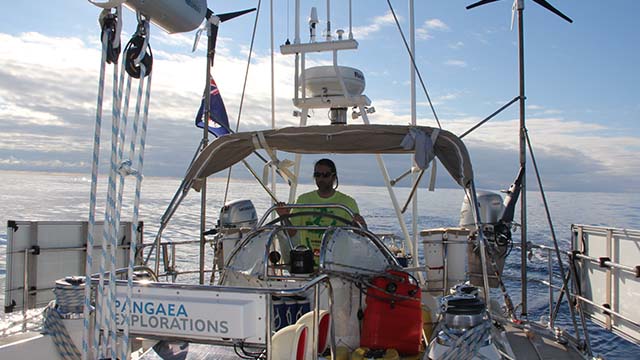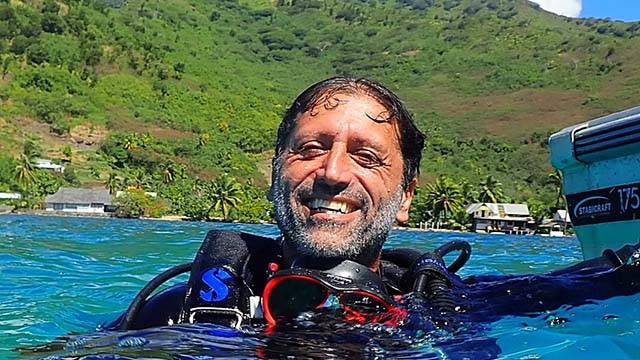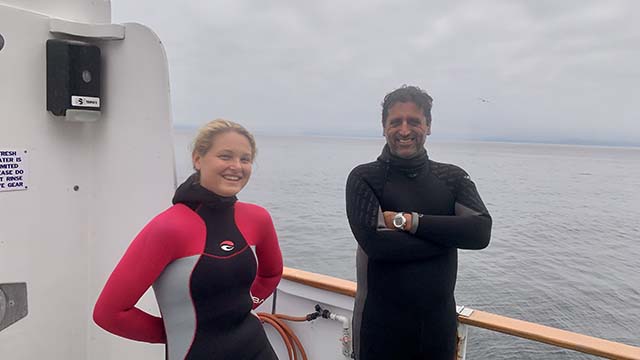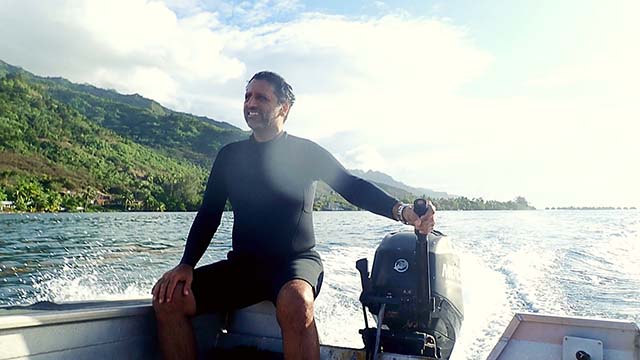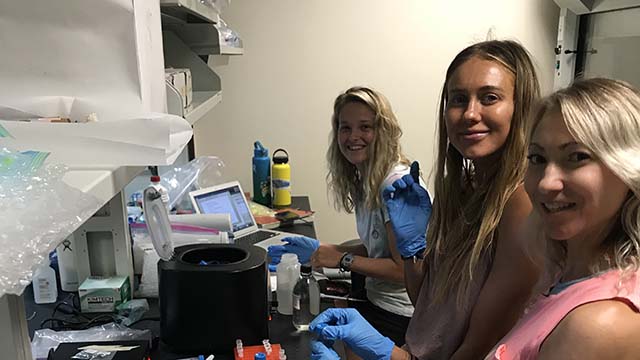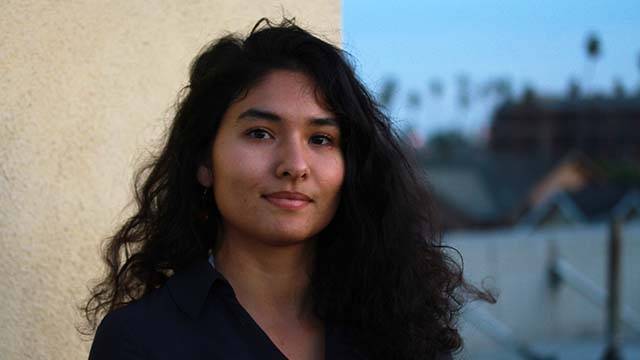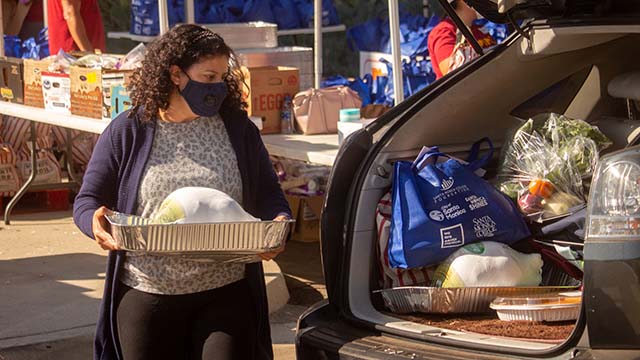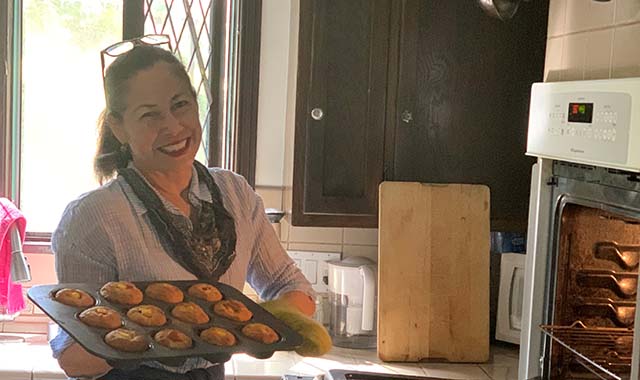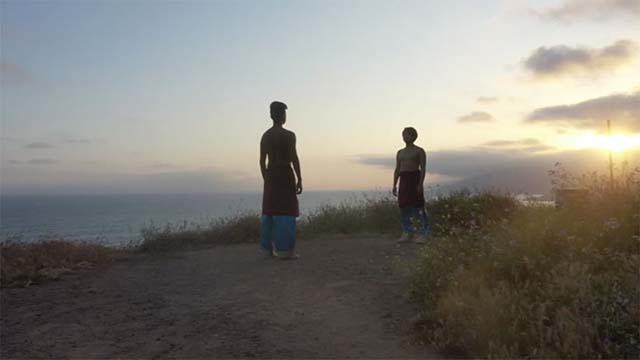The Teacher Who Loved the Sea

If coral colonies could walk and talk, they’d surely be patting Garen Baghdasarian on the back and burbling praise.
Whacky as that sounds, consider how surreal the Santa Monica College marine biologist’s
research is: In scenes reminiscent of SpongeBob SquarePants, Garen and his student assistants recently tended an underwater coral garden in Tahiti, accompanied by their faithful finned friend, Sir Pufferfish. Like dental hygienists in scuba gear, they used toothbrushes to scrub algae from
the tiny marine invertebrates, which Garen harvested from outer reef colonies and
lovingly transplanted to tables bolted to the seabed.
Don’t be fooled by the comical visuals. The “coral gardening” was a prelude to serious,
data-driven research at UC Berkeley’s Bump Station. The goal: to discern how changes in sea temperature, algae growth and natural genetic
variations among 20 different coral colonies make the tiny polyps more or less resilient.
Garen is currently crunching the data. His findings, which he’ll turn into a journal
article while on sabbatical next spring, should shed new light on coral bleaching—the mysterious global blight that, in 2016 alone, killed off 30 percent of the coral population along Australia’s 1,500-miles Great Barrier Reef.
Ripple Effects
Important as his coral nature-nurture research is, it’s Garen’s work as a teacher
that produces the most dazzling results.
He’s been teaching “Biology 15: Marine Biology” for 20 years. Thousands of Corsairs have taken the popular course, with powerful
ripple effects. Semester after semester, he draws bright young minds into the field—students
who’d never thought twice about kelp forests or algae blooms.
Case in point: Chelsea Rochman. An assistant professor of ecology and evolutionary biology at University of Toronto, she’s an international authority on microplastic pollution and a scientific advisor
to the Ocean Conservancy and a National Geographic Explorer. Her 28-person research team at UT is at the forefront of understanding the physical
and chemical fate of plastic “microbeads” and their impact on marine ecosystems.
Fifteen years ago, however, Chelsea remembers arriving at SMC feeling “a little bit
lost.” She was interested in many things— performing arts, journalism, kinesiology.
She never imagined a marine biology class “would be a pivotal moment in my life.”
But Garen’s enthusiasm was infectious. “We didn’t just do labs and listen to lectures:
we took field trips to tidepools and underwater ecosystems,” she says. Chelsea became
a biology major, transferred to UC San Diego, and eventually earned her PhD in marine ecology through a joint program of UC Davis and San Diego State University. Looking back, she marvels at how a great teacher can influence young, undecided
students, giving them direction and jumpstarting fruitful careers.
"I am incredibly grateful to Garen,” she says.
She’s hardly unique.
Tomorrow’s Ocean Stewards
“Garen has created thousands of lifelong ocean stewards by way of his former students,”
says Shaun Wolfe, another alum whose life changed after taking Bio 15.
Shaun was a 20-year-old music performance major who felt “burned out and unfulfilled”
before his marine biology epiphany. It happened after Garen screened Tapped, a 2009 documentary showcasing “the cradle-to-grave environmental disaster that is
the bottled water industry,” in Shaun’s words.
“I knew from that point forward I wanted to create images and tell stories that would
have a similar effect on others,” he says.
Shaun switched his major to marine biology and enrolled in the first of many photography
courses. He’s now a professional cinematographer and photojournalist specializing in underwater and natural history film. His clients include National Geographic, Netflix, and Apple TV+. After transferring to USC, he went on for his master’s in environmental science and
management at UC Santa Barbara. He worked as a scientific diver on conservation projects and in the aquarium industry
before his filmmaking career took off.
“None of this would have happened if not for Garen’s class,” he says, “because I didn’t
know that this sort of career path was a possibility until I met Garen.”
Life-changing Trips
Even students who don’t experience epiphanies are putty in Garen’s hands. “This is best illustrated,” Shaun says, “by the fact that every student in my class made the three-and-a-half-hour trip to Montaña de Oro State Park to go tide pooling with Garen.”
It was an optional field trip. Mandatory field trips take students to places like
Catalina Island, Morro Bay, El Matador and Palos Verdes.
But for a few lucky Corsairs, Garen’s course has been a ticket to faraway places like
Hawai’i, Taiwan and French Polynesia.
In 2019, Garen invited Alexis Codding and Kellie Flowers to join his summer expedition to Moorea. Both had previously aced his class. Together the research team built from scratch
an array of outdoor seawater aquariums, complete with pumps, screens and electrical
systems needed for precise manipulation of water temperature, light levels and other
ambient conditions. Next, they dove into Garen’s coral garden to retrieve the transplanted
coral specimens, run the aquarium experiments and collect the biological data related
to coral bleaching.
“He literally changed my life,” says Alexis, 27, of her experiences at Garen’s side.
Formerly an actress, she’d wandered into Bio 15 three years ago out of curiosity.“I
was not enrolled in any other classes,” says the Sonoma, California native. “I wasn’t continuing my education. I was simply fascinated by
the ocean and wanted to learn more. I walked out of his class a changed person with
a new life’s purpose. I wanted to continue my studies, pursue a PhD, conduct research,
and eventually become a marine biology professor myself.”
She enrolled fulltime at SMC, went to work in Garen’s campus lab, earned scientific
dive certification and has since transferred to Cal State Long Beach, where she’s finishing up her bachelor’s degree in marine biology.
Research teammate Kellie Flower, 37, came to Moorea by an even more circuitous path.
A burned-out fashion industry professional, she enrolled at SMC to pursue “my biggest
passion—marine biology.”
“It was one of the scariest things I have ever done,” says the Hermosa Beach resident, who had earned a bachelor’s in fashion design at Virginia Commonwealth University and worked her way up in the profession over eight years.
“The very first class I took at SMC was Garen’s marine bio course,” she says. “It made
me realize that I had not made a mistake by quitting my career. He encouraged me and believed in me. And now
I am on my way to grad school!”
Next semester, Kellie begins her master’s program in marine biology at James Cook University in Queensland, Australia.
Tehran to Tahiti
Garen’s own love-affair with the sea started serendipitously.
Born in Tehran, he and his ethnic Armenian parents had emigrated to Germany after the Iranian revolution, then moved again to Glendale when Garen was 14. (He’s fluent in Farsi, Armenian, German and English—“though I’ve got an accent in every language I speak,” he says, with a self-deprecating
laugh.)
Entering UCLA as a halfhearted pre-med freshman, he discovered his true calling in
a recreational scuba class. After one dive, Garen switched to marine biology; he stayed
on for his PhD and post-doctoral work at the Westwood campus before joining SMC’s faculty in 2001.
Twenty years later, he and his wife, Sara—an artist, writer and horse trainer—are happy as clams living in Santa Monica with
their 6-year-old daughter, Willow.
What’s not to love?
“I get to teach,” Garen says. “I get to go on and on about marine biology. I get to
take students camping in Morro Bay and hang out in the tide pools at El Matador.”
In addition to marine biology, Garen has taught zoology, general biology, environmental
biology, cellular biology and evolution at SMC. A fifth-degree black belt in Okinawan karate, he also teaches martial arts through the Kinesiology Department.
Swinging for the Fence
His past leadership roles at the college have included chairing the Life Sciences Department, directing the Center for Environmental and Urban Studies, and co-chairing the SMC Global Citizenship Study Abroad committee. He’s currently part of a multidisciplinary faculty team looking into developing
certificate programs for “blue economy” careers in aquaculture and eco-tourism.
As a field researcher based at a community college, Garen says he can “swing for the
fence, because my career doesn’t depend on that next publication. I can ask those
difficult questions.”
His past investigations have looked at predator/prey interactions and the impact of
plastic micro-pollutants in the ocean. More recently, his focus has shifted to the
effects of global warming and ocean acidification on coral reefs.
But few things are more rewarding than teaching.
“I feel I make a difference at SMC,” Garen says. “We get so many students who don’t
believe in themselves, and all it takes is someone just believing in them. They have
their aha moment, and they’re brilliant. They’re absolutely brilliant.”
* * *




